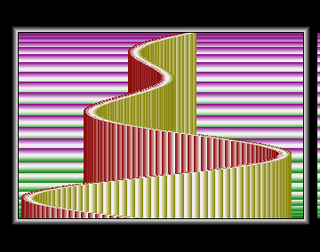- Raster bar
-
- Rasterbar redirects here. For the computing library libtorrent from Rasterbar see libtorrent (Rasterbar).
DemosceneConcepts Demo - Intro - Demoparty - Effects - Demogroup - Compo - Music disk - Diskmag - Module file - Tracker Alternative demo platforms Amiga - Apple IIGS - Atari ST - Commodore 64 - Vic-20 - Text mode - ZX Spectrum Parties Current: Alternative Party - Assembly - Buenzli - Evoke - The Gathering - Sundown - X Past: Breakpoint - Mekka & Symposium - The Party Websites Hornet Archive - Scene.org - Mod Archive - Trax in Space Software ProTracker - Scream Tracker - Fast Tracker - Impulse Tracker - ModPlug - Renoise Tracker musicians Demosceners The raster bar (also referred to as rasterbar or copperbar) is an effect used in demos that displays animated horizontal bars of colour that extend into the overscan area of the display. The effect was very common in demos on the Commodore 64, Commodore Amiga, Atari ST, ZX Spectrum and Amstrad CPC.
The computers of the 8 and 16 bit era typically did not or could not display video memory across the entire screen, leaving a border around the regular display area. The graphics chip commonly used a fixed entry in the colour look-up table (CLUT) to colour this border area. The basic principle of the raster bar effect is that this CLUT entry is updated with a new colour during the horizontal blanking interval, when the TV's electron beam is returning to the left to begin drawing a new scanline, thus changing the border colour for just that scanline. By carefully gradiating the colour changes, an effect of metallic-looking horizontal bars can be achieved.
Many graphics chips can trigger an interrupt when the horizontal blanking interval begins, and thus an interrupt handler can perform the task of updating the CLUT entry.
This effect may have been considered impressive to those who were unfamiliar with how it worked, because the computer appeared to be displaying multiple colours in the "off-limits" border area, and because the traditional way of creating and animating such horizontal lines (by colouring pixels individually) would require intensive CPU performance that most CPUs of the time could not attain.
It also has to be said that changing the CLUT was not the only way that graphics could be displayed in the border area of the screen. The Commodore 64 had a trick in which the programmer could fool the graphics chip to display sprites in the border, and the Atari ST could use other tricks to extend the area available for displaying graphics to the borders. In both of these cases, however, the tricks involved triggering features in the graphics chips that were not actually implemented by design.
The Commodore Amiga had a graphics coprocessor referred to as the Copper that could be programmed to perform the effect, hence the term "Copperbars". In each frame of the demo, a new Copper list (Copper program) would be generated in order to animate the bars.
Vertical raster bars
A similar effect can be generated vertically, although it often does not extend into the overscan border areas. To generate vertical bars, the same line of video memory is repeatedly output every scanline. At the top of the frame, the video memory is typically blank, and every horizontal blanking interval it is updated with a new "bar" in a slightly different position, creating a "stepped" effect.
Vertical raster bars are often called Kefrens bars, after the Amiga demo group that popularized them. However, the effect was implemented earlier by the Alcatraz demo group.
See also
Categories:- Computer graphics
- Demo effects
Wikimedia Foundation. 2010.



